Interacting objects, Newton's 2nd
and 3rd laws, conservation laws
Newton's second law
Two masses (m1 = 15 kg and m2 = 20 kg) are connected by
a massless cord and placed on a horizontal, frictionless surface. The
two-mass system is pulled to the right by a force FA = 60 N using a
cord that makes an angle of 40 degrees with the horizontal. The masses
remain on the horizontal surface. There is no vertical motion.
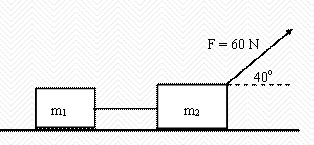
(a) Draw the free body diagrams for the two masses, properly labeling all
forces.
(b) What is the normal force between mass m2 and the
horizontal surface?
(c) What is the acceleration of the system?
(d)
What is the tension FT in the cord between the two masses?
Problem:
A 100 kg man climbs a vertical rope with an acceleration of 12 cm/sec2.
Find the tension in the rope.
Solution:
- Concepts:
Newton's 2nd and 3rd laws
- Reasoning:
Man pulls on rope --> rope pulls on man. Fnet(upward) on man = T - mg
= ma.
- Details of the calculation:
T = mg + ma = 100kg (9.8 + 0.12) m/s2 = 992 N.
Problem:
The force F in the figure below pushes a block of mass M =
5 kg, which in turn pushes a block of mass m = 1 kg. There is no friction
between M and the supporting surface. If the friction coefficient between the
two blocks is μ, how large must F be if
the block of mass m is not to slip?
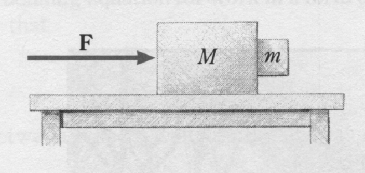
Solution:
- Concepts:
Newton's laws, gravity, friction
- Reasoning:
The gravitational force on m is Fg = mg in the negative y
direction.
The maximum force of static friction is fs =
μsN in the positive y
direction.
We want mg = μsN.
- Details of the calculation:
The normal force accelerates m. N = ma.
The acceleration is given by a = F/(M + m).
We therefore need mg = μs
m F/(M + m).
The minimum applied force F is given by F = g(M + m)/μs.
Problem:
Consider the system of 3 masses shown below.
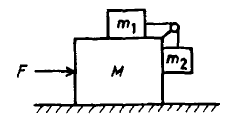
Assume all surfaces to be
frictionless and the inertia of pulley and cord to be negligible.
Find the horizontal force necessary to prevent any relative motion of M, m1,
and m2.
Solution:
- Concepts:
Newton's laws, gravity
- Reasoning:
If there is no relative motion of the masses, then all three masses have the
same horizontal acceleration.
The vertical component of the net force on m2 must be zero.
- Details of the calculation:
For the total mass: F = (M + m1 + m2)a
For the masses individually: m1a = T, m2g
= T --> a = m2g/m1.
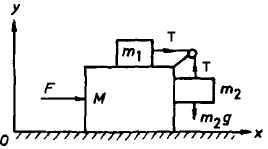
F = (M + m1 + m2)m2g/m1.
Problem:
Near the surface of Earth, two masses, m1 = 1 kg and m2
= 3 kg, are connected by a string of negligible mass. The masses hang on
opposite sides of a pulley with radius R. The pulley is fixed, and the
string can slide over the pulley.
(a) Find the acceleration of the masses if there is no friction between
the string and the pulley.
(b) Find the acceleration of the masses if the coefficient of kinetic
friction between the string and the pulley is μ = 0.1.
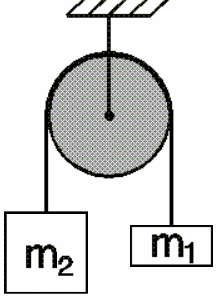
Solution
- Concepts:
Interacting objects, Newton's laws
- Reasoning
The frictional force in
part (b) is proportional to the normal force. We have to find the normal
force a small section of rope exerts on the cylinder.
- Details of the calculation:
(a)
The tension is the same everywhere in the string. The mass m2
will accelerate downward and the mass m1 will accelerate upward
with acceleration a.
m2g - T = m2a. T - m1g = m1a.
a = g(m2 - m1)/m2 + m1) = (9.8
m/s2)/2 = (4.9 m/s2).
(b)
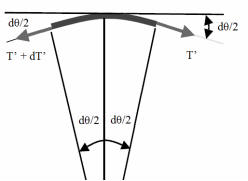
Consider an infinitesimally small section of string of length Rdθ, acted on by the forces T'' = T'
+ dT' and T' as shown.
The magnitudes of the tangential and normal components of these forces are
T't = T'cos(dθ/2), T'n = T'sin(dθ/2), T''t =
T''cos(dθ/2), T''n = T''sin(dθ/2).
The magnitude of the net tangential force is T''t - T't =
dT'cos(dθ/2) = dT'.
The magnitude of the net normal force is N = (2T' + dT')sin(dθ/2) = T'dθ since
dθ is infinitesimal and we only keep first order terms in the small quantities.
Since the string has negligible mass,
dT' = μN = μT'dθ,
dT'/T' = μdθ,
Integrating from θ = 0 to θ = π we find ln (T2/T1) = μπ,
T2/T1 = exp(μπ).
m2g - T2 = m2a.
T1 - m1g = m1a. T1 = T2exp(-μπ).
a = g(m2exp(-μπ) - m1)/m2exp(-μπ) + m1)
= (9.8 m/s2)*0.37= (3.7 m/s2).
Problem:
Consider a glass that is resting on top of a tablecloth. The glass has
mass m1 and the tablecloth has mass m2. Suppose the
coefficient of static friction between the tablecloth and glass is given by μs,
and the table is highly polished so it is nearly frictionless.
What is the
maximum force that the tablecloth can be pulled horizontally so that the glass
and table cloth move together without slipping?
Solution:
- Concepts:
Newton's 2nd and 3rd
laws
- Reasoning:
Let us draw a free-body diagram.
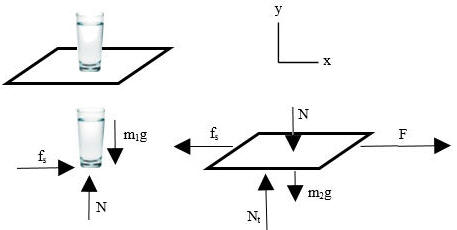
- Details of the calculation:
(a) x-direction: F - fs
= m2a.
fs = m1a.
y-direction: fs
max = μsN = μsm1g.
Combining: (F
- fs)/m2 = fs/m1, Fmax/m2
= μsm1g(1/m1 + 1/m2).
Fmax
= μs(m1 + m2)g.
Problem:
A light flat ribbon is placed over the top of a triangular prism as shown in
the diagram. Two blocks are placed on the ribbon. The
coefficients of static and kinetic friction between the ribbon and the blocks
are μs and μk, respectively. There is no friction
between the ribbon and the prism. The angle θ and the masses of the blocks
m and M are given. Assuming that M > m, find the acceleration of the
ribbon along the prism after the blocks are simultaneously released. Consider
all possible cases.
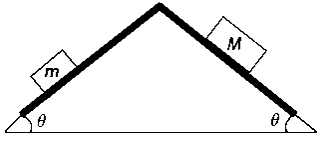
Solution:
- Concepts:
Newton's second law, friction
- Reasoning:
There are two scenarios.
(i) If θ < θc,
where θc is some critical angle, then neither block will slide on
the ribbon. The ribbon will pull on the blocks (by means of static
friction) with a tension force T. The smaller block then accelerates
uphill and the bigger one accelerates downhill with the same acceleration.
(ii) If θ < θc, then the smaller block will slide while the
ribbon sticks to the larger block. (Since the ribbon is massless, the forces
of friction exerted on it by each block must always have equal magnitudes.
Therefore, as a function on θ, the static friction limit is always be
reached first by the smaller block, and the larger block never slides along
the ribbon.)
- Details of the calculation:
(i) Assume neither block slides on the
ribbon.
a = (T - mg sinθ)/m = (Mg sinθ - T)/M.
Solving for the unknown
tension,
T = 2g sinθ[Mm/(M + m)]. Therefore
a = {[2g sinθ][Mm/(M +
m)] - mg sinθ}/m = (g sinθ)[M - m)/(M + m)].
The critical θc
is reached when the ribbon tension becomes equal to the smaller block's
static friction limit. In that limiting case we have
2g sin θc
[Mm/(M + m)] = μsmg cosθc, tan θc = (μs/2)(1
+ m/M).
(ii) When the smaller block is sliding, the ribbon tension
is equal to the sliding friction between the smaller block and the ribbon, T
= μkmg cosθ.
The bigger block and ribbon then have downhill
acceleration given by
a = [Mg sinθ - μkmg cosθ]/M = g[sinθ - μk(m/M)
cosθ].
As the ribbon slides uphill under it, the smaller block has
downhill acceleration given by:
a = [mg sin θ - μkmg cos θ]/m
= g (sinθ - μk cos θ).
(If μk > tan θ, then the
smaller block's acceleration will be negative, i.e. uphill.)
Newton's third law
Problem:
Sandra, who has a mass m = 40 kg stands on a M = 28 kg flatboat. Her
distance to the shore is 9.4 m. She walks 2.6 m along the boat toward the
shore and then stops. How far is she away from the shore? Assume there is no
friction between the boat and the water.
Solution:
- Concepts:
Newton's third law
- Reasoning:
As she walks a distance d1 towards the shore the
boat moves a distance d2 away from the shore. The center of
mass does not move.
- Details of the calculation:
With respect to the shore: md1
= Md2. d1 = (2.6 - d2).
40 kg(2.6 - d2)
= 28 kg d2,
68 kg d2 = 40 kg 2.6 m,
d2
= 1.53 m.
She has walked 1.07 m towards the shore. Therefore she is now
8.33 m from the shore.
Problem:
A cat and a dog are sitting on the top of a small wagon
which is a rest. The mass of the dog is 20 kg and the mass of the cat is 5 kg.
There is no friction between the wagon and the ground. The cat jumps from the
wagon and then the dog jumps in the same direction from the already moving
wagon. When the dog jumps off, the wagon's velocity increases seven fold. The
horizontal components of the dog's and the cat's velocities before touching the
ground are the same. What is the wagon mass?
Solution:
- Concepts:
Momentum conservation
- Reasoning:
If no external forces act on a system along some axis, the component of the
total momentum of the system along that axis is constant.
- Details of the calculation:
Let the motion occur along the x-axis. Let p and v refer
to magnitude of the x-components of the momentum and the velocity, respectively,
with respect to the ground.
ptotal = 0. Let M denote the mass of the wagon.
cat jumps off: -(5 kg)vcat + (M + 20 kg)v1 = 0. vcat
= (M + 20 kg)v1/(5 kg).
dog jumps off: -(20 kg)vcat + 7Mv1 = (M + 20 kg)v1.
(The dog and the cat have the same speed relative to the ground.)
-4(M + 20 kg) + 7M = (M + 20 kg).
M = 50 kg.
Conservation laws
Problem
Two blocks of mass M and 3M are placed on a horizontal frictionless surface.
A light spring is attached to one of them, and the blocks are pushed together
with the spring between them. A cord holding them together is burned, after
which the block of mass 3M moves to the right with a speed of 2 m/s.
(a) What is the speed of the block of mass M?
(b) Find the original elastic potential energy in the spring if M = 0.35 kg.
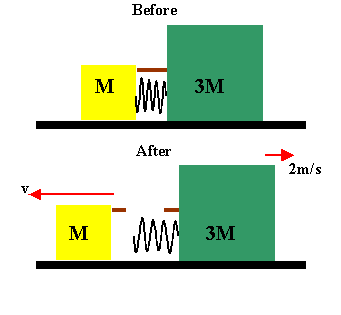
Solution:
- Concepts:
Conservation of momentum, conservation of energy
- Reasoning:
The total initial momentum of the system is zero. No outside force act on
the system in the horizontal direction, so the final horizontal momentum
component of the system is also zero.
The total energy E = T + U of the system is conserved.
- Details of the calculation:
(a) conservation of momentum:
p3M + pM = 0.
p3M = 3M (2 m/s), pM = -3M ( 2m/)s = -6M m/s. vM
= -6 m/s.
The block of mass M moves towards the left with a speed of 6 m/s.
(b) conservation of energy:
After the string has been cut and the spring has relaxed, E = T =
½3M(2 m/s)2 + ½M(6 m/s)2 = 8.4 J.
Initially E = U = 8.4 J, the total energy is the elastic energy stored in the
spring.
Problem:
If two objects collide and one is initially at rest, is it
possible for both to be at rest after the collision? Is it possible for
one to be at rest after the collision? Explain!
Solution:
- Concepts:
Conservation of momentum
- Reasoning:
If a component of the total external force acting on a
system is zero, then the corresponding component of the total momentum is
conserved.
- Details of the calculation:
In collisions between two objects
momentum is conserved. Since the initial momentum is not zero, the final
momentum is not zero. Both objects cannot be at rest.
It is possible for
one of the objects to be at rest after the collision. For example, if the
masses of the two objects are equal, then after a head-on elastic collision
the object initially at rest is moving and the object initially moving is at
rest.
Problem:
A sled on which you are riding is given an initial push and slides across
frictionless ice. Snow is falling vertically (in the frame of the ice) on the
sled. Assume that the sled travels in tracks which constrain it to move in a
straight line. Which of the following three strategies causes the sled to move
the fastest?
(i) You sweep the snow off the sled so that it leaves the sled in the direction
perpendicular to the sled's tracks, as seen by you in the frame of the sled.
(ii) You sweep the snow off the sled so that it leaves the sled in the
direction perpendicular to the sled's tracks, as seen by someone in the frame of
the ice.
(iii) You do nothing.
Order the strategies from best to worst and explain the ordering.
Solution:
- Concepts:
Conservation of momentum:
- Reasoning:
There are no external horizontal forces on the sled and the snow, so the total
momentum of the sled plus the snow is constant in time.
- Details of the calculation:
From best to worst, the ordering of the strategies is (ii), (iii), (i).
Strategy (ii) beats strategy (iii). The snow in (ii) ends up with no forward
momentum, while the snow in (iii) continues to move forward with the sled. The
snow in (ii) therefore has less forward momentum than the snow in (iii), so the
sled in (ii) must have more forward momentum than the sled in (iii).
Strategy (iii) beats strategy (i). When a snowflake is brushed off the sled in
strategy (i), it initially has the same forward speed as the sled as they both
sail across the frictionless ice. But when the next snowflake hits, the
brushed-off sled-snowflake system has less mass than the not brushed system, and
therefore slows down more.








